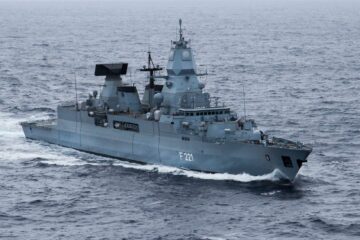The concept, dubbed “Zielbild der Marine ab 2035” (Target posture of the Navy from 2035) was taken down within hours of publishing, but can still be accessed here. On enquiry by defense journalist Harry Lye the service responded that the document had not been finalized and the release happened in error.
While details are therefore subject to change, the released outline allows an interesting insight into operational thinking of the German Navy going forward.
The “Zielbild” at its core considers: A renewed focus on the North Atlantic, North Sea and Baltic Sea-areas of operation. Furthermore, a significant transition to drone-based operations, with uncrewed systems complementing crewed platforms for aerial, surface and subsurface warfare, based on the rationale that “mass matters”. Finally, while a commitment to low-intensity operations especially in a global context is acknowledged, the clear focus is on peer to peer-warfare covering the spectrum from surveillance over surface and anti-submarine warfare to maritime strike against land-based targets.
Centerpiece of the document is a breakdown of ships and aircraft in service beyond 2035. To illustrate changes, figures from the previous plan for 2031 are also listed. The overall effect is a significant acceleration in introducing several new combatants and supporting technologies, while multiple existing platforms may see withdrawal from service far ahead of original projections.

At the top of the list is F127, the new AAW-frigate succeeding the Sachsen-class (F124) currently in service. Previous official statements already clarified that Bundeswehr intends to double the number of hulls, from three F124 to six F127, reflecting an increased need for long range air defense-focused hulls, including the new capability of sea-based missile defense. The old plan aimed for five F127 from 2031, itself an ambitious schedule, given existing F124 are currently scheduled to undergo a significant mid-life refit with new radar systems starting in 2024. Supporting an accelerated introduction of F127 was a report on March 8 in local German media on a new design proposal by Thyssen Krupp Marine Systems (TKMS). The TKMS-design envisions a substantial warship displacing 12,000 tons, at a hull length of 220 meters and with a complement of 250, incorporating the American AEGIS-combat system.
The ”Zielbild”-plan also maintains a need for six F126-frigates, with four ships so far under contract. In a step change, the Navy appears keen to retire at least one F125-frigate ahead of time, with three out of four units active by 2035. In the same vain K130 corvette-numbers appear to be fluid, with 6-9 units considered for active service, whereas at present at least 10 K130 will be operated.
Significant cuts may also affect naval NH-90-helicopters. The original aim was to buy 31 new “Sea Tiger”-helicopters replacing Sea Lynx for ASW-duty on German frigates. The document changes this figure to “To be established”. The utility-version, known as “Sea Lion” would see numbers cut by one, from 18 to 17.
A deciding factor driving several of these changes is the widespread introduction of uncrewed systems. In this context a new USV dubbed “Future Combat Surface System” would complement K130. For helicopters a VTOL-UAV of up to 22 units would be bought. Currently the German Navy is already introducing the SAAB Skeldar in a comparable role. Other notable additions would be a fixed wing-drone complementing P-8A Poseidon ASW/MPA-planes and a new “large unmanned underwater vehicle” supporting the future submarine fleet centred on Type 212CD, which itself would see additional hulls, with 6 to 9 in service.
Most of these drones so far have not seen clear definition, let alone programs of record. It therefore remains to be seen how a final official release will reconcile both budgetary and timeline pressures in realizing such an ambitious reconfiguration for the German Navy.






